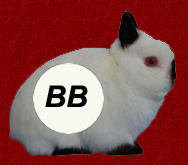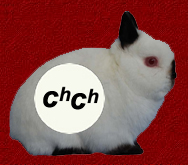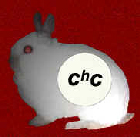Himalayan ch

The ch
allele is responsible for Himalayan Netherland Dwarfs.
Ch is also referred to as restricted
albino, meaning the colour is restricted to the points, leaving the body
void of pigment - or white. The points
include the nose, ears, feet and legs, and tail.
They eyes are not included in any of these points, and are therefore void
of pigment and pink like in the 'full' albino.
In the Himalayan, there is no yellow pigment covering the fur shafts of
the coloured points and only two units of black pigment available to provide the
point colour.
The agouti-patterned Himalayan will show
mixed 'roan' colour on
the points due to its nature to band the fur shafts.
However, since the fur is so short on those portions comprising the
points, definite bands of colour can scarcely be detected.
The normally white portions of the agouti will be evidenced by white
intruding into the coloured extremities of the Himalayan.
The underside of the tail and insides of the legs will be white.
Light nostril edging will appear in the Himalayan's mask, and the inner
ears will show a lighter colour. The
breed standard's description of the Himalayan variety, requiring that the upper
as well as lower side of the tail to be well-coloured precludes exhibiting
agouti-patterned Himalayans. Agouti-patterned
Himalayans are A and ch
in genotype.
It is the self-patterned Himalayan that is himalayan


Himalayan (correct genotype) Himalayan (chc)
Here again, even though the Himalayan's points are coloured with only two
units of black pigment, the colour appears as dense as in the full colour
Blacks, Blues, Browns and Lilacs. The
Please note that while breeding medium-shaded Marten Sables requires a heterozygous genotype, (cchlch
or cchlc), breeding properly coloured,
well marked Himalayans requires a homozygous
genotype (aa chch).
Some recognised Netherland Dwarf varieties cannot
breed true to colour due to
the heterozygous genotype necessary to produce their colour in the first place.
The Marten Sable and Siamese Sable are two examples of varieties
requiring a heterozygous genotype
and these varieties can
be expected to produce a percentage of offspring of other
varieties they
carry a recessive gene for (such as Himalayan or Ruby-Eyed White).
There are a few varieties which will invariably breed true to colour, such as the Ruby-Eyed White and Blue-Eyed
White
while most varieties can be successfully bred in heterozygous
or homozygous genotypes.
Full
Colour C
back to colour distribution in the fur shaft
extension of colour in the fur shaft